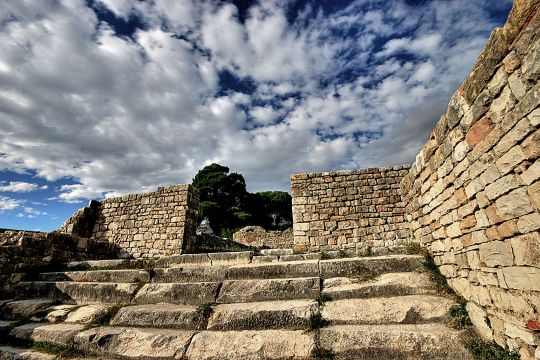Salona’s main ecclesiastical centre was created next to the first Christian oratorium that was located in a private house, in the so-called domus ecclesiae . It was in an area surrounded on the western side by town walls, in the east by a street leading to the small gates in the north town walls, and on the southern side by the street passing through the old town gate known as Porta Caesarea. In the remains of the private house next to the town walls, the oratorium hall with its semicircular apse is visible, complete with a stone bench for the priests and the altar-screen base. This is believed to have been the first Christian oratorium, called Oratorium A by Dyggve. In its vicinity, to the south, there was another one, that Dyggve called Oratorium B. Bulić, too, considered this was where the Christian community was meeting at the time of Domnio, the first Salonitan bishop. To the west, there was a door and before it there was a small atrium with a fountain (the thermae and water installations were in the vicinity). Later on, Gabričević differed in his opinion that the oratorium was built at the time of Venancius, probably the first Christian community in the locality at the beginning of the second half of the third century.
After the Edict of Milan in 313 , the Christian community was granted legality of public worship and the building of a large religious complex, extending to several layers, was started in Salona in the years to come. The building works took several centuries to complete. All the structures required by a Christian community for religious service were erected: firstly one and then another large church, baptistery, the bishop’s residence, atrium and ante-rooms. The main approach to the complex was from the south, through a monumental entrance with four columns. From there, one entered the narthex, the common antechamber on the eastern side of both in parallel to the basilicas. The old pavement and stairs approaching the baptisterial complex on the northern side of the narthex are well preserved, too.
The northern church, called by Bulić the town basilica (Basilica urbana), believing this was the Salona’s main, bishopric, church, is a basilica with a nave, two aisles and a large semicircular apse with priest benches along its wall. Construction was commenced by the bishop Simpherius in the fourth century, and ended by his successor, bishop Exigius, cum clero et populo (with clergy and people), as described on a preserved mosaic fragment. The church was dedicated to Christ. Just like other contemporary churches, it was rebuilt several times, especially in the fifth century.
To the south and next to this church, there had been another basilical church, above which a large cruciform church was built at the time of the bishop Honorius II (died 547), in the first half of the sixth century. This bishop is known from documents as the convenor of the ecclesiastical assemblies of Salona in 530 and 533, very important for establishing the ecclesiastical power in Dalmatia.
[Edit mode] Swiper Gallery: att Bazilika









